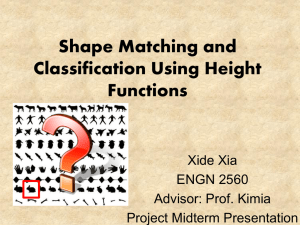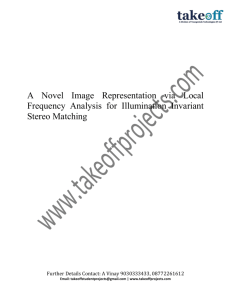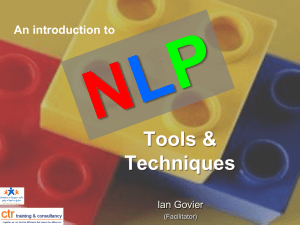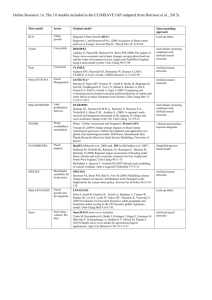an attempt to optimize the process of automatic - mit
advertisement
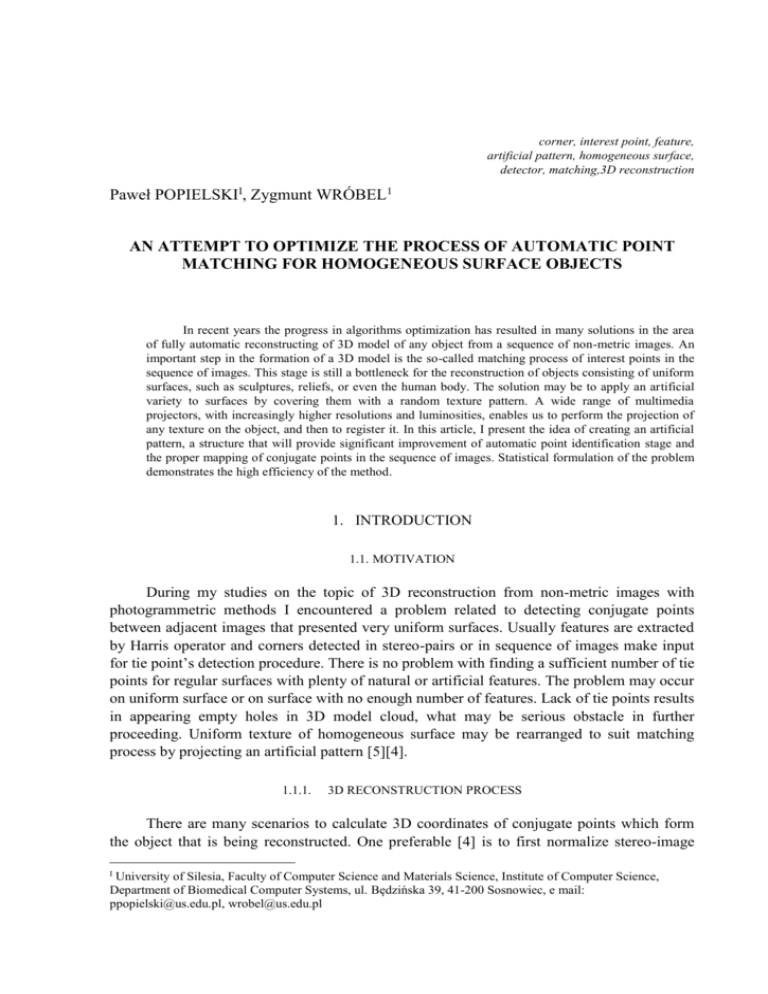
corner, interest point, feature,
artificial pattern, homogeneous surface,
detector, matching,3D reconstruction
Paweł POPIELSKII, Zygmunt WRÓBEL1
AN ATTEMPT TO OPTIMIZE THE PROCESS OF AUTOMATIC POINT
MATCHING FOR HOMOGENEOUS SURFACE OBJECTS
In recent years the progress in algorithms optimization has resulted in many solutions in the area
of fully automatic reconstructing of 3D model of any object from a sequence of non-metric images. An
important step in the formation of a 3D model is the so-called matching process of interest points in the
sequence of images. This stage is still a bottleneck for the reconstruction of objects consisting of uniform
surfaces, such as sculptures, reliefs, or even the human body. The solution may be to apply an artificial
variety to surfaces by covering them with a random texture pattern. A wide range of multimedia
projectors, with increasingly higher resolutions and luminosities, enables us to perform the projection of
any texture on the object, and then to register it. In this article, I present the idea of creating an artificial
pattern, a structure that will provide significant improvement of automatic point identification stage and
the proper mapping of conjugate points in the sequence of images. Statistical formulation of the problem
demonstrates the high efficiency of the method.
1. INTRODUCTION
1.1. MOTIVATION
During my studies on the topic of 3D reconstruction from non-metric images with
photogrammetric methods I encountered a problem related to detecting conjugate points
between adjacent images that presented very uniform surfaces. Usually features are extracted
by Harris operator and corners detected in stereo-pairs or in sequence of images make input
for tie point’s detection procedure. There is no problem with finding a sufficient number of tie
points for regular surfaces with plenty of natural or artificial features. The problem may occur
on uniform surface or on surface with no enough number of features. Lack of tie points results
in appearing empty holes in 3D model cloud, what may be serious obstacle in further
proceeding. Uniform texture of homogeneous surface may be rearranged to suit matching
process by projecting an artificial pattern [5][4].
1.1.1.
3D RECONSTRUCTION PROCESS
There are many scenarios to calculate 3D coordinates of conjugate points which form
the object that is being reconstructed. One preferable [4] is to first normalize stereo-image
I
University of Silesia, Faculty of Computer Science and Materials Science, Institute of Computer Science,
Department of Biomedical Computer Systems, ul. Będzińska 39, 41-200 Sosnowiec, e mail:
ppopielski@us.edu.pl, wrobel@us.edu.pl
pairs using epipolar geometry. Then interest points are extracted followed by matching
process to identify the conjugate points. The matched tie points are tracked through captured
neighboring images and then multiple light ray intersection is performed to finally calculate
coordinates of all points belonged to reconstructed surface. Next all the surfaces are combined
simultaneously using the homogeneous points on reconstructed surfaces in a least square
adjustment procedure. In testing procedure several artificial patterns will be tested to decide
on their suitability in the process of point matching. The concise introduction of Harris
detector and normalized cross-correlation (NCC) concepts are needed, as crucial elements of
testing procedure.
Matching process requires a detection of conjugate points what may be automated by
identifying surface features. Features can be extracted using the Harris corner detector [6]
which is a popular interest point detector based on the local auto-correlation function of a
signal, what is indeed the sum of squared differences (SSD) similarly to Moravec algorithm
[8]. SSD given by equation (1) is calculating between an image patch over the area (u,v) and
its shift by (x,y).
𝑆(𝑥, 𝑦) = ∑𝑢 ∑𝑣 𝑤(𝑢, 𝑣)(𝐼(𝑢 + 𝑥, 𝑣 + 𝑦) − 𝐼(𝑢, 𝑣))
2
(1)
In the equation the weighted sum of squared differences between two patches is denoted
as S(x,y). The lower number indicates more similarity in the image and local maximal value of
the number indicates that a feature of interest is present. The advantage the Harris detector
over the Moravec method is to replace shifted patches with the differential of the corner score
with respect to direction directly what produces the approximation (2).
𝑆(𝑥, 𝑦) ≈ ∑𝑢 ∑𝑣 𝑤(𝑢, 𝑣)(𝐼𝑥 (𝑢, 𝑣)𝑥 − 𝐼𝑦 (𝑢, 𝑣)𝑦)
2
(2)
In the equation (2) the partial derivatives of I are denoted as Ix and Iy. This improvement
hugely reduced the calculation complexity of the algorithm. If we apply a circular window or
circularly weighted window (Gaussian function) the response will be isotropic, what is
another huge advantage over Moravec method. Finally in (3) eigenvalues of the Harris matrix
(A) are replaced with determinant(A) and trace(A) what makes next computational
improvement in terms of time complexity.
𝑀𝐶 = 𝜆1 𝜆2 − (𝜆1 + 𝜆2 )2 = 𝑑𝑒𝑡(𝐴) − 𝑡𝑟𝑎𝑐𝑒 2 𝐴
(3)
The normalized cross-correlation [7] is well-known area-based matching method for
assessing the image similarity Small windows composed of grey values are used as matching
primitives to perform comparisons over uniform zones of images until the best
correspondence is reached. Cross-correlation term c(u,v) in (4)
𝑐(𝑢, 𝑣) = ∑𝑥,𝑦 𝑓(𝑥, 𝑦)𝑡(𝑥 − 𝑢, 𝑦 − 𝑣)
(4)
is a measure of the similarity between samples. Serious drawback of cross-correlation
was requirement to maintain the regular lighting conditions between image sequences.
Another disadvantage was that the correlation between exact samples might be smaller than
the correlation between the feature and for instance a bright spot.
Normalized cross-correlation, given by equation (5)
𝛾(𝑢, 𝑣) =
̅ ][𝑡(𝑥−𝑢,𝑦−𝑣)−𝑡̅]
∑𝑥,𝑦[𝑓(𝑥,𝑦)−𝑓𝑢,𝑣
2
1
(5)
̅ ] ∑𝑥,𝑦[𝑡(𝑥−𝑢,𝑦−𝑣)−𝑡̅]2 }2
{∑𝑥,𝑦[𝑓(𝑥,𝑦)−𝑓𝑢,𝑣
significantly reduces the above disadvantages. Lewis proved supremacy of NCC over
the other matching methods in typical applications.
2. TESTING PROCEDURES
2.1. SETUP OF THE HARDWARE
As sample material a standard mannequin that can be found in any textile shop was
used. To reduce time consuming proceedings only face area images were acquired. For testing
purposes sequence of photos was reduced to stereo-pairs. Pictures were taken in two series. At
first orthogonal pictures were taken, where the axis of the lens were perpendicular to baseline.
Next convergent pictures were taken, where axis of the lens were directed towards one point
on the dummy torso. Distance from the camera tripod to the dummy was fixed to 2 meters and
baseline also was fixed to 80 cm (Figure 1).
Figure 1. The most difficult thing is to get proper light setup.
2.2. EXAMINED PATTERNS
To investigate the efficiency of the identification of conjugate points on homogeneous
surface photos were taken at regular day light without any pattern and then with seven
different types of patterns.
First pattern (Figure 2) was generated by MATLAB function image = rand([rows
columns]) and consisted from squares in various shades of gray.
Figure 2. Fifty-by-fifty matrix made up of various
shades of gray.
Figure 3. 50 by 50 matrix consisting of black and
white squares
Second pattern (Figure 3) was produced with Yuki Kamitani's Matlab Image Tools
randomly generating black and white squares [11].
The ratio of black squares to white squares was set up to 0.5.
Sub-block ID
3
4
8
11
Encoded pattern
1
0
0
0
1
0
0
1
0
1
1
0
0
1
0
1
0
0
1
1
0
1
1
0
Corresponding
image
0
0
0
0
0
0
0
0
0
0
0
0
Table 1. Examples of Chang's tree-by-tree sub-blocks
Third pattern (Figure 4) was designed by Yu Chuan Chang [4] and consisted of tree-bytree sub-blocks (Table 1), arranged in pattern in a random way.
Originally much more sub-blocks were constructed, but finally, after many tests, only
eleven were chosen as the most distinct from one another.
For the purpose of this study Chang’s pattern was redesigned to a unique pattern
consisting of ten blocks, two-by-two (Table 2) and tree-by-tree squares.
Figure 4. Chang’s pattern consisting of 9 randomly arranged blocks
Sub-block ID
Encoded pattern
0
0 1
1 1
1
1 0
0 0
2
0 1
0 0
3
1 0
1 1
4
0 0
0 1
5
1 1
1 0
6
1 1
0 1
7
0 0
1 0
8
0 1
1 0
9
1 0
0 1
Corresponding
image
Table 2. Two-by-two blocks used in testing procedure
Two-by-two blocks were designed to allow Harris detector discovers as many corners
as it possible, inside the block and on outside edge as well. An option with tree-by-tree blocks
is actually a copy of the two-by-two blocks. The only distinction is white stripe left at the
bottom and on the left to prevent sub-blocks touch each other. Because sub-blocks are
arranged automatically black dots from neighboring blocks may form black spots. Bluring
white and black spots may result in poor feature detection. For test purposes we used white
colour of the stripe, because Chang in his pattern used black one.
Figure 5. Random pattern consisted of 2-by-2 blocks.
Figure 6.Pi-random pattern consisted of 2-by-2 blocks.
Fourth and fifth pattern (Figure 5, Figure 7) is arranged from blocks selected randomly.
Last two types of patterns (Figure 6, Figure 8) are arranged from blocks selected in a special
way.
Figure 7. Random pattern consisted of 3-by-3 blocks.
For a long time scientists have been investigating the uniqueness of the digit of π [3].
The question if the π is random remains still unanswered. Certainly the most elementary
mathematical hypothesis will continue to intrigue people for many years. Mathematicians are
still exploring the most modern algorithms and mathematical formulas to prove randomness
of π [2]. Based on latest research [1] we decided to use the digit of π to arrange ten blocks to
form artificial π-random pattern.
Data used in our function was downloaded from the site of the Yasumasa-KanadaLaboratory (www.super-computing.org). It holds the decimal representation of the first 4.2 x
109 digits of Ludolph's number.
Figure 8. Pi-random pattern consisted of 3-by-3 blocks.
We assigned each block one decimal digit as ID (Table 2). Started from decimal point,
we’re walking along the π reading digits and inserting corresponding blocks into pattern
matrix (Figure 6, Figure 8). What we get seems be very similar to regular random matrix.
2.3. THE PROCEDURE
Figure 9. Red crosses indicate detected corners.
Figure 10.Blue lines show conjugate points before and
after filtering.
Firstly points of interest were detected (Figure 9) in the pictures with Harris corner
detector (Table 3 & Table 4 - left pic. & right pic.).
Then matching process (Figure 10) was performed with normalized cross-correlation
(Table 3 & Table 4 - putative matches). Next the output was filtered and outliers were
eliminated (Table 3 & Table 4 - filtered matches).
Only for plain pictures taken without projected any pattern, local contrast enhancement,
was applied. Wallis filter was utilized [9] to improve performance of the matching process.
All pictures were converted with MATLAB function rgb2gray to grayscale intensity
image. The , a tunable sensitivity parameter was set at the value 0,04 suggested in literature.
The searching window parameter of the normalized cross-correlation process was set to
value 31.
Pictures were cropped to show only the face, what helped to improve performance of
tests and at the same time remained without effect on test results.
3. RESULTS
convergent pictures
pattern
left pic.
right
pic.
putative
matches
filtered
matches
efficiency
gain
[%]
1
2
3
4
5
6
7
no
pattern
1350
1255
2497
1305
951
1420
900
1573
1358
2724
1539
961
1551
977
670
592
871
617
286
682
279
412
392
500
429
147
475
171
1004
956
1219
1046
358
1158
417
395
416
87
41
0
Table 3. The result of matching on convergent pictures.
Comparing the number of matched points from all the columns we can clearly see how
efficient the method with pattern projection is.
orthogonal pictures
pattern
left pic.
right
pic.
putative
matches
filtered
matches
efficiency
gain
[%]
1
2
3
4
5
6
7
no
pattern
2151
1894
2427
1970
1819
1976
1799
2360
1943
2709
2159
2088
2117
2075
874
656
843
694
580
693
571
631
384
570
433
352
422
348
1660
1010
1500
1139
926
1110
915
381
403
81
38
0
Table 4. Result of matching on orthogonal pictures.
There is no doubt that the influence of an artificial pattern enriched homogenous surface
in much more than significant way. The mean value of efficiency gain (Table 3 & Table 4 –
efficiency gain) for both series on the level of 1000 % demonstrates that we are dealing with a
brilliant improvement.
High efficiency of Chang’s pattern has been confirmed. We also observe comparable
effectiveness of patterns number 1, 4 and 6.
4. CONCLUSIONS
As proofed matching stage of the reconstruction process of homogenous surface may be
significantly improved with the help of artificial pattern.
Weakness of the method is limitation of projector luminosity. During the day may occur
difficulties connected with outdoor conditions like direct sunlight or weather conditions.
Significant drawback may be still limited range of projection offered by projectors. The
method may be limited to indoor conditions.
Even creation of perfect illumination conditions doesn’t make a perfect picture. To take
proper picture in regularly lighted scene there is needed a very experienced camera operator.
Further development of encoded patterns would be desirable. Because of the fact that
the pattern layout is known it is possible to track the location of features in the picture, which
may not only improve the timing, but even totally redesign matching process.
Another future challenge is to utilize genetic programming to automatically synthesize
image operators that can detect interest points (Trujillo, 2008).
BIBLIOGRAPHY
[1]
[2]
[3]
[4]
[5]
[6]
[7]
[8]
[9]
[10]
[11]
Bailey D., Borwein J., Mattingly A., Wightwick G., 2011, The Computation of Previously Inaccessible
2011, http://crd.lbl.gov/~dhbailey/dhbpapers/bbp-bluegene.pdf, (accessed 15 Apr. 2011)
Bailey D., The BBP Algorithm for Pi, 2006, http://crd.lbl.gov/~dhbailey/dhbpapers/bbp-alg.pdf (accessed
15 Apr. 2011)
Berggren L., Borwein J.M. and Borwein P.B., 2004, Pi: a Source Book, Springer-Verlag New York, USA
Chang Y., 2008, A Photogrammetric System for 3D Reconstruction of a Scoliotic Torso, A Master
Thesis, Department of Geomatics Engineering, University of Calgary, Canada
D’Apuzzo N., 2002, Measurment and Modeling of Human Faces from Multi Images, International
Archives of Photogrammetry and Remote Sensing 34(5), pp 241-246
Harris C., Stephens M., 1998, A combined corner and edge detector, Proceedings of Alvey Vision
Conference, 15: pp 147-151
Lewis, J. P. Fast normalized cross-correlation, 1995, Vision Interface, pp 120–123
Moravec H. Obstacle Avoidance and Navigation in the Real World by a Seeing Robot Rover, 1980, Tech
Report CMU-RI-TR-3 Carnegie-Mellon University, Robotics Institute, USA
Remondino F., 2003, 3D Reconstruction of Static Human Body with a Digital Camera, Videometrics VII,
SPIE Electronic Imaging, Vol. 5013, pp. 38-45, El-Hakim, Gruen, Walton (Eds), Santa Clara (California),
USA
Trujillo L., Olague G., Automated design of image operators that detect interest points, 2008,
Evolutionary Computation 16 (4), pp 483–507
http://www.cns.atr.jp/~kmtn/imageMatlab/index.html, Yuki Kamitani's webpage with MATLAB to ols.


